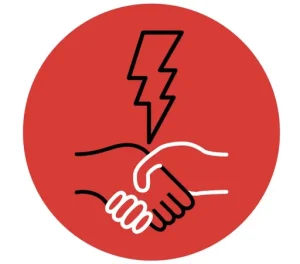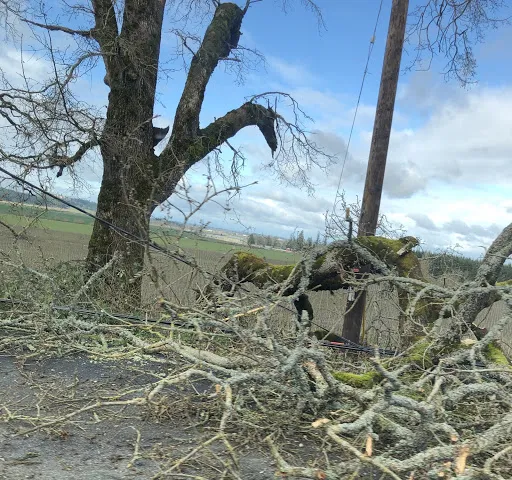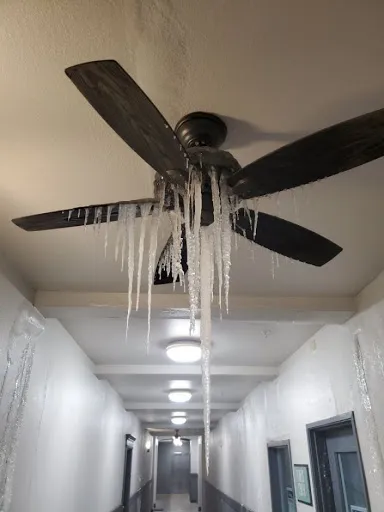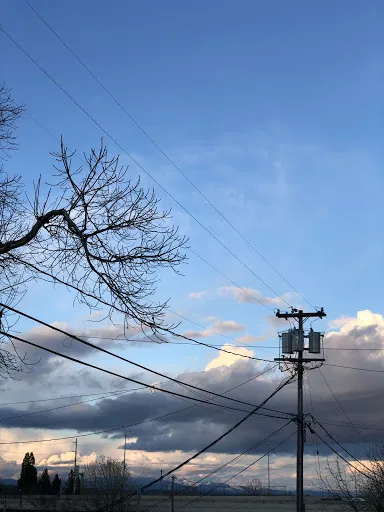By Emily Castle and Serena Howell, Portland DSA Ecosocialist Working Group

- After historic winter storms, Oregon and Texas both suffered massive, predictable grid failures. At the same time, millions of people face mounting utility debt and the threat of shut-offs due to nonpayment in the midst of the pandemic.
- Investor owned utility companies (IOUs) are privately owned, for-profit monopolies that pay dividends to shareholders. IOUs have a long history of neglecting grid safety and accessibility in favor of paying out shareholder dividends, astronomical executive salaries, and political lobbying.
- The Electric Reliability Council of Texas (ERCOT) oversees 90% of Texas’s grid, which is the only deregulated market in the US not overseen by the Federal Energy Regulatory Commission (FERC).
- Despite many prior warnings, lack of oversight by ERCOT resulted in millions of Texans losing power for days in freezing temperatures, with at least 38 deaths. Meanwhile, electricity producers made $40 billion.
- Publicly owned utilities do not operate for a profit. There are thousands of them across the US and they provide more affordable, reliable, accessible, and safer service than IOUs. They are democratized organizations that operate transparently and benefit communities in numerous ways.
- With public power we can expand access to electricity, uplift marginalized communities, improve grid safety and efficiency, build resilience to climate-related disasters, and quicken the transition to renewable energy.
- Through grid nationalization and a Green New Deal, we can put millions of people to work improving the stability of our energy system, slow climate breakdown, and place power into the hands of the public.
A crisis of power
Oregon is currently recovering from an historic winter storm that, at its peak, left more than 420,000 people without power in freezing temperatures. Though regulators had warned the two largest electric companies (PGE and Pacific Power) to maintain the vegetation near the power lines, falling limbs from ice-laden trees tore down hundreds of miles of lines in the worst damage to the system in 40 years. For several days, hundreds of thousands of people shivered in the dark and thousands have been left without power for weeks as workers scramble to repair the complex distribution web.¹
The onslaught of bitter temperatures, snow, and ice wreaked even more serious havoc on the grid farther south in Texas as it made its way into a region generally considered safe from the dangers of extreme winter weather. The local grid operator, which has also ignored weatherization recommendations from regulators, implemented rolling blackouts to mitigate the stress of the cold on the system, but the utilities failed to come back online. More than 4.5 million people were plunged into darkness as temperatures remained below freezing. Three days into the crisis, as millions still lacked electricity, the state placed more than a quarter of its residents under a “boil order,” as low water pressure caused unsafe drinking water. At least 38 people in Texas have perished, with the number rising to 58 across the many other affected states.²

Access to reliable power is the lifeblood of modern civilization. It is simply a requisite component of the society we’ve built: modern living requires machinery, and that machinery requires power. While energy bills are a reality for everyone, the poor are disproportionately shouldered with the cost burden of keeping the lights on. Utility bills essentially function as a regressive tax because the rates are the same for low-income people as they are for wealthy people.³ Under our current system, working class people cannot afford modernized energy efficiency appliances and weatherization upgrades to their homes. According to Pew Research, nearly 37% of Americans rented their homes in 2016 and they are ultimately at the mercy of the property managers to implement the upgrades needed to keep their energy bills affordable.⁴ Due to centuries of targeted racial and environmental oppressions, Indigenous communities on reservations, communities of color in cities, and migrant communities that provide our food disproportionately suffer from high utility costs — or a lack of access altogether. For example, Native American nations were largely excluded from the New Deal’s Rural Electrification Act and tens of thousands of Indigenous people do not have electricity to this day.⁵ High energy costs, in turn, force people to choose between necessities like food, medicine, and heat. The health problems associated with making these kinds of choices and living in drafty or damp conditions aggravate economic distress further through increased medical bills and/or lost wages.⁶
The COVID-19 crisis has put millions of people out of work, creating a situation where unemployed workers are racking up higher utility bills while bringing in little or no income. There is no federal rule on utility moratoriums during COVID-19, which can mean accruing crippling debt for power, water, and gas bills. Only eleven states, including California, Washington, and Hawaii, have active bans on utility shut-offs. Texas is one of twenty-two states that had utility moratoriums at the onset of the pandemic but allowed them to expire. In North Carolina approximately 30,000 households lost their water, electricity or gas in November after the state’s shut-off moratorium expired. There are more than 600,000 customers in the state still behind on utility payments.⁷
Currently there are eleven states, including Oregon, that have voluntary-based moratoriums on utility shut-offs. Larger investor-owned utility companies, like Portland General Electric and Pacific Power, have voluntarily frozen utility shut-offs. PGE reported in June 2020 that its total value of past-due payments doubled between January and June 19, from $14 million to $28 million. Some smaller utilities in the state, such as consumer-owned utilities, have resumed disconnections for unpaid bills; not all are required to share their rates of shut-off notices. The Salem Electric Cooperative and the City of Ashland have resumed disconnections for water and electricity.⁸ As there is no guaranteed financial support attached to them, statewide rent and utility moratoriums leave millions of families with the insecurity of looming evictions and shut-offs when the moratoriums inevitably expire. The National Energy Assistance Directors’ Association estimates there is $24 billion in utility debt that families haven’t been able to pay during the coronavirus pandemic and that amount could nearly double after March 2021. The estimated average balance for families impacted by COVID-19 that are unable to pay their utility bill is approximately $1700 per household.⁹ There is mounting pressure for the federal government to intervene and provide financial support to the millions of Americans struggling to pay their bills in the midst of a national health crisis. There should be debt forgiveness for rent and utilities at the federal level, especially since the key to reducing exposure to COVID-19 is staying home. Not only does access to running water and electricity save lives by slowing the spread of the coronavirus, it also protects low-income communities living and working at the front lines of the climate crisis. So, while millions of working class people struggle to pay their utility bills, with the hardest-hit people belonging to historically marginalized communities along racial and gender lines, who is making money off our energy use?
Profit over people
On November 8th, 2018, a live wire broke loose of an electrical tower and started an inferno that killed 85 people and leveled the town of Paradise, California. The tower was 99 years old and documents show acknowledgement from its owner, Pacific Gas and Electric, that the tower had exceeded its “useful life” 25 years previously. This was not PG&E’s first disaster: the utility giant was found to be at fault for 17 of the 21 most destructive fires of 2017 and a gas pipe explosion in 2010 killed eight people. Subsequent investigations show PG&E consistently broke the law or otherwise shirked their safety responsibility in favor of paying out dividends to their private investors. In perhaps the most outrageous example of rampant greed, the decade leading up to the gas line explosion saw the company collect $224 million more in revenue than they were legally allowed to while low spending on operation and maintenance brought them millions of dollars under budget. Though PG&E knew Paradise was in a vulnerable region and had the funds for safety upgrades, it did nothing to prevent an inevitable disaster.¹⁰
A year after the catastrophe in Paradise, PG&E preemptively cut power to 800,000 users in fire-prone areas where the grid has not been adequately maintained. As we’ve seen in Texas, utilities often resort to these kinds of forced shut-offs in the face of calamity — shut-offs that disproportionately affect marginalized populations. In New York City, the utility giant ConEd shut off power to 33,000 customers in southeast Brooklyn in the middle of a July 2019 heat wave. The neighborhoods were majority Black and were rated a 4 out of 5 on the heat vulnerability index.¹¹ As was the case last month when the low-income communities of East Austin were plunged into darkness while the downtown area filled with empty office buildings remained lit, the move begs the question of how companies choose who gets power and who does not.
PG&E and ConEd are investor-owned utilities, or IOUs. IOUs are private corporations that pay dividends to shareholders, who are mostly out-of-state or international. Sixty-eight percent of Americans get their electricity from IOUs, which, because of the regional and technical nature of energy transmission, function as local monopolies. Corporate utilities in the US are monitored by municipal utility commissions — an arrangement suggested by the electric companies around the turn of the century to head off growing demand for public ownership of the grid. Then, as now, capitalist dogma held that the government could never provide a service as successfully as a private corporation.¹² These public utility boards have proven toothless, however. Commissioners are traditionally in the pocket of the utilities themselves and, even if the board wished to hold companies accountable, they lack the capacity to do so without the cooperation of the IOUs. It might go without saying they do not get this cooperation, as IOUs value deregulation above all else.
Texas has fought especially hard to eschew accountability. Deregulation in Texas goes as far back as FDR’s 1935 signing of the Federal Power Act, which gave the Federal Power Commission (now the Federal Energy Regulatory Commission, or FERC) the authority to regulate electricity crossing state lines. Instead of allowing for federal regulation Texas simply decided not to trade electricity with other states. A massive blackout affecting 30 million people in the Eastern US and Canada, however, spooked Texans into forming a state regulatory board in 1970: the Electric Reliability Council of Texas (ERCOT). About 90% of the state is powered by this Texas-only grid, which is the only deregulated energy market in the US that is not overseen by FERC. The Texas Legislature and the Public Utilities Commission of Texas (PUCT) have jurisdiction over ERCOT, but they have chosen not to enforce necessary safety measures to prevent catastrophes.¹³ After severe episodes of winter weather in 1989 and 2011 both left millions of Texans without power, the PUCT recommended winterization improvements to the grid. Federal regulators, such as FERC and the North American Reliability Corporation, suggested that the utilities use more insulation, install heating systems and incorporate more encompassing winterized efforts in the power plants. Because Texas currently has no regulatory penalties for not complying with weatherization guidelines, the utilities, unsurprisingly, largely ignored the recommendations. They failed to train operators and maintenance personnel on winter preparations and failed to ensure that they had adequate fueling.¹⁴
Deregulation coupled with private greed left millions of Texans to pay the ultimate price with power blackouts and water shut-offs, leading to over 30 deaths while hundreds have been poisoned from carbon monoxide, desperate to find ways to stay warm. To add insult to injury, the state’s intentionally competitive wholesale system caused electricity and gas prices for those who did have access to skyrocket, with individual customers being slammed with three, four, and five-digit utility bills. The severely low temperatures resulted in mass spikes in energy demand and during the span of the storm rates jumped from $22 per megawatt-hour to the emergency cap of $9,000 — an increase of 10,000%.¹⁵ Watchdogs later found that ERCOT enforced the emergency surge pricing for days longer than they should have, which piled $16 billion onto the backs of utility providers and their customers (a total more than all of Texas energy trades in 2020).¹⁶ Electricity generators made an estimated $40 billion in windfall revenue from the crisis (natural gas producers raked in similar profits, leading one executive to gleefully describe the devastating situation as “like hitting the jackpot”).¹⁷ ERCOT, which acts as a middleman between producers and providers, is now over $2.5 billion in debt.¹⁸ The extreme price gouging will be at the expense of consumers, either in the form of increased rates or a public bailout (or, likely, both).¹⁹ Consumers will be further harmed by market consolidation. Nearly a quarter of Texas power companies may be forced to transfer their customers to rivals, which could result in the behemoths NRG Energy and Vistra Corp — who is already fighting against relief for debt incurred by ERCOT’s faulty pricing — controlling more than 80 percent of the deregulated market.²⁰

What do investor-owned utilities do with the vast sums of money they collect from their captive customer base in deregulated or under-regulated markets? Besides doling out dividends to Wall Street investors, IOUs pay their executives shockingly high salaries. The Energy and Policy Institute issued their report on executive compensation policies for the top 19 largest IOUs from 2017–2019. They found that CEO compensation totaled over $764 million over three years. The highest-paid CEO, Thomas A. Fanning, based at Southern Company in Atlanta, Georgia, earned roughly $28 million in 2019 and $56 million within that same three-year period. If their company had reallocated 32% of his compensation from 2019 (leaving him $19 million), they could have wiped out the debt of approximately 76,000 customers and ultimately the 13,000 Georgians who had their power disconnected in the midst of a pandemic and sweltering summer heat.²¹
IOUs also spend enormous amounts on political campaigns and lobbying to secure favorable circumstances for maximum profits. This lobbying heavily focuses on less regulation and — alarmingly, considering climate chaos — pushes for more fossil fuel extraction. Two particularly atrocious examples come from Arizona and New York. In Arizona, the giant Pinnacle West spent at least $37.9 million in 2017 to defeat a ballot measure that would require the utility to obtain at least 50% of its energy from renewables by 2030.²² In New York, the UK-based National Grid threatened to stop new gas hook ups unless the state approved construction on a fracked gas pipeline. The company, whose annual revenue is over $20 billion, even went so far as to pester all of its customers with an email blast asking them to support the new pipeline.²³ The results of this rabid prioritization of profits over infrastructure safety and green energy are being acutely felt in Texas and Oregon’s current grid crisis: constant catastrophe.
The path forward
There are three types of bodies from which Americans get their electricity and gas. As discussed above, the largest percentage gets their power from investor-owned utilities, in which privately run corporations operate to make a profit for shareholders. Public, not-for-profit power options include cooperatives, municipal systems, and public utility districts. Cooperatives are owned and governed by members. Co-ops own and maintain 42% of the electric distribution lines in the US, serving over 40 million people.²⁴ Municipal systems are owned and managed by the cities they power. Public utility districts (PUDs) are special districts formed by a vote of the people they serve.²⁵ There are almost 3,000 publicly owned utilities and cooperatives in the US, serving about one in seven people in the United States.²⁶
The Northwest is home to around 120 public utilities which serve about half of the population. In Oregon, we have 38 utilities that are owned either publicly or by their users.²⁷ Nine of the 10 lowest cost utilities in Oregon are public, with the average cost of public power, at 9.2 cents per kWh, coming in well below the IOU average of 11.6 cents per kWh.²⁸ PUDs — which in Oregon are called People’s Utility Districts — are governed by a five-member Board of Directors that is elected by the people within the service area. In the Portland-metro area, Columbia River PUD serves 19,000 people in Columbia County and a small portion of Multnomah County. It has been operating since 1940 and in 1980, in response to the energy crisis of the 1970s, Columbia River PUD purchased the electricity distribution system from the local IOU, Portland General Electric. The PUD grew as voters in surrounding areas voted to annex into the district.²⁹
Because there are no outside investors to pay dividends to, revenue from public power goes directly back into maintaining and updating the grid, making public utility systems safer, more reliable, and more affordable than IOUs. For example, Nebraska is run on 100% public power and its residents pay 15 percent less than the national average for power from a grid that has been rated number one in the US in reliability. On average, public utilities charge customers 13 percent lower rates than investor-owned utilities. Public utilities also give significantly more back to the community than IOUs in the form of taxes, fees, and special services.³⁰ While IOUs operate in the dark, making shady backroom deals outside of the public eye and outside of the public interest, public utilities make decisions in a much more democratized manner, with public meetings and publicly-elected boards. This allows customers to have a say in where the money from their bills goes and where the utility gets its energy from. By having the power to make demands and enforce accountability, users can not only ensure the system is adequately maintained and weatherized, but they can also speed the critical transition to renewable energy. The 116-year-old municipal utility of Burlington, Vermont, for example, completed its transition to 100% renewable energy in 2014, even while maintaining its rates from 2009.³¹ Seattle City Light, the 10th largest public utility in the US, became the first electric utility in the country to become carbon neutral in 2005.³²
Public power revenue and practices uplift historically marginalized communities in ways a corporation beholden to shareholders will never do. Many public utilities offer assistance to low-income users in the form of discounts, financial aid, weatherization, rebates and incentives for efficiency improvements. In this way, public power can help bolster those on the front lines of climate disaster. When catastrophe strikes, like it did recently in Texas, low-income, minority, and otherwise marginalized communities are less likely to have the financial and physical resources available in wealthy, white communities. Their finances are already strained, in part due to the proportionately higher burden utility bills place on the backs of the poor, and their homes are less likely to withstand extreme weather. They may be unable to flee a dangerous situation, while wealthy people can afford to fly to Mexico. By making electricity and weatherization affordable and reliable, public power will mitigate these kinds of disasters that overwhelmingly harm oppressed groups.

The United States has an unreliable energy grid, with power lines, wires, and transformers being used well beyond their life expectancy. Like the loose wire that caused the fire in Paradise, the oldest power lines date back to the 1880’s and the majority of the grid was built in the 50’s and 60’s. The outdated infrastructure can lead to the power flickering in and out periodically and, ultimately, power outages. The rates of power outages are consistently higher in the US than other developed nations. One research study indicated that the average length of annual blackouts in the Midwest was about 92 minutes while in Japan the average was approximately four minutes.³³ Based on a 2017 report from the American Civil Society of Engineering, the current US energy grid received a “D+” report card due to outdated technology and lack of preparation for storms and climate change.³⁴
As members of the Ecosocialist Working Group and Democratic Socialists, we are staunch advocates of transitioning our energy to public power. Our energy grid is outdated, unreliable, and not equipped to weather the climate crisis precisely because it is predominantly operated by investor-owned utilities that exist to make money for their shareholders and that will prioritize profit over people without fail. Publicly-owned utilities, on the other hand, exist to benefit their users. Public power provides safer, greener, and more affordable energy than IOUs and the benefits to the community are extensive. Our energy sources must be democratically-operated, in order to provide ample opportunity for communities to learn about complex systems and to weigh in on comprehensive ways to improve the power structures.
If our power was democratized and made public, all profit would be eliminated. We would be able to harness for public good the astronomical earnings that currently line the pockets of large for-profit corporations and their CEOs — organizations that continue to break their own records year after year, even in the midst of the COVID-19 pandemic and as the country is experiencing an economic recession. We need to democratize our energy sector to ensure that every single person has access to truly affordable power, regardless of their income. By having further democratic oversight, we would be able to reallocate more funding to low-income ratepayers and ensure that there are greater measures in place to avoid any power shut-offs due to nonpayment. If we eliminate the profit-motive, we would be able to invest in local communities by creating more sustainable, affordable rates and make more funding available for payment plans when vulnerable community members need financial support the most.
The long-term vision is transforming our system to a nationalized energy grid, where all energy grids are publicly owned and there is transparency in exactly where our energy sources are coming from. We can no longer take the neoliberal approach to addressing our impending climate catastrophe, in which proponents of capitalism argue that the market will transition to renewables at their own slow-moving pace. Just a few weeks ago in Texas we saw the fallout of the private sphere failing their customers to the degree that it impacted human dignity and caused many lost lives. Conservative politicians such as Texas Governor Gregg Abbot were quick to blame renewable energy and dismiss the calls for a Green New Deal. Left to their own devices, investor-owned utilities and corrupt politicians who have been bought out by the private sphere will not implement the rapid changes that we need to survive. With a nationalized grid, we could mandate the critical changes necessary to transform our energy grid to renewables to combat the climate crisis.
Nationalizing our energy sector would mean that we could dictate, enforce, and fully fund the changes that need to occur on a national scale. For example, we need to mandate resilience-based upgrades across the country in order to prepare the grid to withstand more extreme weather patterns and rapidly changing conditions such as the wildfires we experienced across the state in 2020. We also need to incorporate more advanced technology and update the power lines and various infrastructure that is dangerously outdated. In the instances of the 2020 fires and the winter storm of last month, upkeep of vegetation around — or the burying of — power lines could have prevented much destruction. We need to rapidly decarbonize our economy. With a nationalized energy grid, there would be more opportunity to phase out dirty polluters and prevent more fossil fuels from going into the atmosphere. We will do so through a just transition, by ensuring no worker in the fossil fuel industry is left in the dust and without a comparable-paying job. We absolutely need to transition to more renewable power at the speed and urgency that the climate crisis calls for and we would be able to do so at the scale needed through public power and, ultimately, nationalization. We would also need to nationalize the expansive fossil-fuel sector to enforce the speed and efficiency required for the transition to occur. If we had a supergrid, we would be able to import energy from different parts of the country that have excess renewable power on reserve and import it to regions of the country in need.
We need to enact the Green New Deal. By doing so we would be able to get millions of Americans back to work through a job guarantee that provides the training and skill-set necessary to implement the upgrades needed through our energy infrastructure. An empowered Labor movement is critical to the success of Democratic Socialism’s goals and taking control of power production and distribution will be an important step towards the elevation of the working class. With a public, nationalized energy grid we would be able to allocate the resources necessary to build and/or retrofit homes and public buildings to withstand the extreme weather patterns we will continue to experience, replace outdated appliances, and do mass-scale grid weatherization projects — all while employing millions of public, union-represented workers all across the country. Legislation to expand access to union representation is scheduled for a House vote on March 10th. The PRO Act — Protect the Right to Organize — would make it easier for workers to form a union and harder for companies to undermine worker power. It is a crucial step in our struggle for a just transition.
Capital’s rabid extraction of resources and labor has resulted in constant global disasters — of climate catastrophe, environmental devastation, extinction, exploitation, inequality, sickness, and societal collapse. As Democratic Socialists, we recognize that Capital will never stop expanding and will never voluntarily relinquish power. Therefore, the only chance we have to pull ourselves back from the brink is to wrest control out of the hands of the few and place it into the hands of the many. As ecosocialists, we believe that a path towards decarbonization, democratization, and decommodification are essential for climate justice. There is a growing movement across the country to take on the corruption of investor-owned utilities. DSA chapters across the country are calling for IOU’s to be transformed into democratically-run public power. Chapters such as New York, San Antonio, Chicago, and San Diego have active public power campaigns. The Portland Chapter of DSA meets frequently with the Salem Chapter of Oregon to conduct research on what it would take to get a public power campaign off the ground regionally. Please join us in this path towards public power. To learn more on how to get involved in the growing movement, please contact us at ecosocialistpdx@protonmail.com.
Sources
1. “Fewer than 9,000 remain without power in northwest Oregon nearly two weeks after winter storm.” Oregon Live. https://www.oregonlive.com/pacific-northwest-news/2021/02/power-outages-in-northwest-oregon-down-to-around-10000-nearly-two-weeks-after-winter-storm.html
2. “Extreme Cold Killed Texans in Their Bedrooms, Vehicles and Backyards.” New York Times. https://www.nytimes.com/2021/02/19/us/texas-deaths-winter-storm.html
3. People’s Power: Reclaiming the Energy Commons. Ashley Dawson. https://www.orbooks.com/catalog/peoples-power/
4. “More U.S. households are renting than at any point in 50 years.” Pew Research Center. https://www.pewresearch.org/fact-tank/2017/07/19/more-u-s-households-are-renting-than-at-any-point-in-50-years/
5. “The Land Electrification Forgot.” IEEE Spectrum. https://spectrum.ieee.org/energy/fossil-fuels/parts-of-the-navajo-nation-are-still-off-the-gridbut-thats-changing
6. “Energy, Poverty, and Health in Climate Change: A Comprehensive Review of an Emerging Literature.” Frontiers. https://www.frontiersin.org/articles/10.3389/fpubh.2019.00357/full
7. “‘Tidal Wave’ of Evictions, Utility Shutoffs Tests Lawmakers.” Pew Research Center. https://www.pewtrusts.org/en/research-and-analysis/blogs/stateline/2021/01/28/tidal-wave-of-evictions-utility-shutoffs-tests-lawmakers
8. “Some Oregon utilities continue disconnecting customers.” OPB. https://www.opb.org/article/2020/08/26/some-oregon-utilities-resume-disconnecting-customers/
9. “Unemployed, But ‘Hopeful’: How Struggling Families Are Navigating Rent, Utility Bills Piling Up.” WBUR. https://www.wbur.org/hereandnow/2020/10/27/utility-rent-bills-debt
10. “California Wildfires: How PG&E Ignored Risks in Favor of Profit.” New York Times. https://www.nytimes.com/interactive/2019/03/18/business/pge-california-wildfires.html
11. “During deadly heat wave, New York utility cut power to high-risk neighborhoods.” grist. https://grist.org/article/during-deadly-heat-wave-new-york-utility-cut-power-to-high-risk-neighborhoods/
12. Ashley Dawson, People’s Power.
13. “So What is ERCOT Anyway?” Houstonia. https://www.houstoniamag.com/news-and-city-life/2021/02/what-is-ercot
14. “Texas Was Warned a Decade Ago Its Grid Was Unprepared for Cold.” Bloomberg. https://www.bloombergquint.com/technology/texas-was-warned-a-decade-ago-its-grid-was-unprepared-for-cold
15. “Texas Energy Crisis Is An Epic Resilience And Leadership Failure.” Forbes. https://www.forbes.com/sites/arielcohen/2021/02/19/texas-energy-crisis-is-an-epic-resilience-and-leadership-failure/?sh=546f9c6b6eee
16. “Texas Watchdog Says Grid Operator Made $16 Billion Error.” Bloomberg. https://www.bloomberg.com/news/articles/2021-03-04/texas-watchdog-says-power-grid-operator-made-16-billion-error?sref=Os5mORbE
17. “White House says Biden is ‘eager’ to go to Texas, possibly as soon as this week.” Washington Post. https://www.washingtonpost.com/nation/2021/02/21/winter-weather-texas-updates/
18. “Texas Watchdog Says Grid Operator Made $16 Billion Error.”
19. “Texas’s Power Market Is $1.3 Billion Short After Energy Crisis.” Bloomberg. https://www.bloomberg.com/news/articles/2021-02-27/texas-s-power-market-is-1-3-billion-short-after-energy-crisis
20. “Texas power crisis could cripple small marketers, unravel market deregulation.” Reuters. https://www.reuters.com/article/us-usa-weather-texas-power-idUSKBN2AQ2ZM
21. “Pollution Payday: Analysis of executive compensation and incentives of the largest US investor-owned utilities.” Energy and Policy Institute. https://www.energyandpolicy.org/utilities-executive-compensation-analysis/
22. “Newly revealed reports show that energy and utility giants poured $60 million into campaigns.” Fast Company. https://www.fastcompany.com/90338797/newly-revealed-reports-show-that-energy-and-utility-giants-poured-60-million-into-campaigns
23. “National Grid Asks Customers to Help it Lobby for a New Fracked Gas Pipeline.” The American Prospect. https://prospect.org/environment/national-grid-asks-customers-help-lobby-new-fracked-gas-pipeline/
24. “America’s Electric Cooperatives.” National Rural Electric Cooperative Association. https://www.electric.coop/wp-content/uploads/2021/01/Co-op-Facts-and-Figures.pdf
25. “PUDs in Oregon.” Columbia River PUD. https://www.crpud.net/my-pud/about-puds-public-power/puds-in-oregon/
26. Ashley Dawson, People’s Power.
27. “Oregon Utilities.” Oregon.gov. https://www.oregon.gov/energy/energy-oregon/Pages/Oregon-Utilities.aspx
28. “Coast to coast, public power costs less.” American Public Power Association. https://www.publicpower.org/periodical/article/coast-coast-public-power-costs-less
29. “PUD History.” Columbia River PUD. https://www.crpud.net/my-pud/about-puds-public-power/pud-history/
30. “Public Power Pays Back.” American Public Power Association. https://www.publicpower.org/system/files/documents/Public-Power-Pays-Back-2020-update.pdf
31. “Publicly Owned Utilities Could Help Fight the Climate Crisis.” Teen Vogue. https://www.teenvogue.com/story/public-utilities-energy-grid
32. “Climate Change and Energy.” Seattle City Light. https://www.seattle.gov/city-light/energy-and-environment/environment/climate-change-and-energy
33. “The US has more power outages than any other developed country. Here’s why.” Popular Science. https://www.popsci.com/story/environment/why-us-lose-power-storms/
34. Report Card for America’s Infrastructure. American Society of Civil Engineers. https://infrastructurereportcard.org/cat-item/energy/
